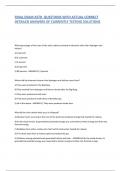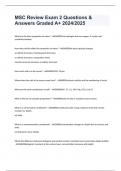FINAL EXAM ASTR QUESTIONS WITH ACTUAL CORRECT
DETAILED ANSWERS OF CURRENTLY TESTING SOLUTIONS
What percentage of the mass of the solar nebula consisted of elements other than hydrogen and
helium?
A) 0 percent
B) 0.1 percent
C) 2 percent
D) 20 percent
E) 80 percent - ANSWER-C) 2 percent
Where did the elements heavier than hydrogen and helium come from?
A) They were produced in the Big Bang.
B) They evolved from hydrogen and helium shortly after the Big Bang.
C) They were produced inside stars.
D) They were produced inside dense interstellar gas.
E) all of the above - ANSWER-C) They were produced inside stars.
Why did the solar nebula heat up as it collapsed?
A) Nuclear fusion occurring in the core of the protosun produced energy that heated the nebula.
B) As the cloud shrank, its gravitational potential energy was converted to kinetic energy and then into
thermal energy.
C) Radiation from other nearby stars that had formed earlier heated the nebula.
D) The shock wave from a nearby supernova heated the gas.
E) Collisions among planetesimals generated friction and heat. - ANSWER-B) As the cloud shrank, its
gravitational potential energy was converted to kinetic energy and then into thermal energy.
,Why did the solar nebula flatten into a disk?
A) The interstellar cloud from which the solar nebula formed was originally somewhat flat.
B) The force of gravity from the Sun pulled the material downward into a flat disk.
C) As the nebula cooled, the gas and dust settled onto a disk.
D) It flattened as a natural consequence of collisions between particles in the spinning nebula, changing
random motions into more orderly ones.
E) The force of gravity from the planets pulled the material downward into a flat disk. - ANSWER-D) It
flattened as a natural consequence of collisions between particles in the spinning nebula, changing
random motions into more orderly ones.
What happened during the accretion phase of the early solar system?
A) Atoms and molecules in the gas bonded together and solidified.
B) Particles grew by colliding and sticking together.
C) The solar nebula differentiated into metals inside of the frost line and ices beyond.
D) Large planetesimals captured atmospheres from the solar nebula.
E) Earth gained its oceans from icy planetesimal capture. - ANSWER-B) Particles grew by colliding and
sticking together.
According to our theory of solar system formation, why do all the planets orbit the Sun in the same
direction and in nearly the same plane?
A) The original solar nebula happened to be disk-shaped by chance.
B) Any planets that once orbited in the opposite direction or a different plane were ejected from the
solar system.
C) The laws of conservation of energy and conservation of angular momentum ensure that any rotating,
collapsing cloud will end up as a spinning disk.
D) The Sun formed first, and as it grew in size it spread into a disk, rather like the way a ball of dough can
be flattened into a pizza by spinning it.
E) Luck explains it, as we would expect that most other solar systems would not have all their planets
orbiting in such a pattern. - ANSWER-C) The laws of conservation of energy and conservation of angular
momentum ensure that any rotating, collapsing cloud will end up as a spinning disk.
,Which of the following lists the ingredients of the solar nebula from highest to lowest percentage of
mass of the nebula?
A) light gases (H, He), hydrogen compounds (H2O, CH4, NH3), rocks, metals
B) hydrogen compounds (H2O, CH4, NH3), light gases (H, He), rocks, metals
C) light gases (H, He), hydrogen compounds (H2O, CH4, NH3), metals, rocks
D) hydrogen compounds (H2O, CH4, NH3), light gases (H, He), metals, rocks
E) hydrogen compounds (H2O, CH4, NH3), rocks, metals, light gases (H, He) - ANSWER-A) light gases (H,
He), hydrogen compounds (H2O, CH4, NH3), rocks, metals
What percentage of the solar nebula's mass consisted of hydrogen and helium gases?
A) 0.5 percent
B) 5 percent
C) 50 percent
D) 98 percent
E) 100 percent - ANSWER-D) 98 percent
What percentage of the solar nebula's mass consisted of rocky material?
A) 0 percent
B) 0.4 percent
C) 2 percent
D) 20 percent
E) 80 percent - ANSWER-B) 0.4 percent
What kind of material in the solar nebula could remain solid at temperatures as high as 1,500 K, such as
existed in the inner regions of the nebula?
A) rocks
B) metals
C) silicon-based minerals
D) hydrogen compounds
E) molecules such as methane and ammonia - ANSWER-B) metals
, What was the frost line of the solar system?
A) the distance from the Sun where temperatures were low enough for metals to condense, between
the Sun and the present-day orbit of Mercury
B) the distance from the Sun where temperatures were low enough for rocks to condense, between the
present-day orbits of Mercury and Venus
C) the distance from the Sun where temperatures were low enough for hydrogen compounds to
condense into ices, between the present-day orbits of Mars and Jupiter
D) the distance from the Sun where temperatures were low enough for asteroids to form, between the
present-day orbits of Venus and Earth
E) the distance from the Sun where temperatures were low enough for hydrogen and helium to
condense, between the present-day orbits of Jupiter and Saturn - ANSWER-the distance from the Sun
where temperatures were low enough for hydrogen compounds to condense into ices, between the
present-day orbits of Mars and Jupiter
Why are the inner planets made of denser materials than the outer planets?
A) The Sun's gravity pulled denser materials toward the inner part of the solar nebula, while lighter gases
escaped more easily.
B) Denser materials were heavier and sank to the center of the nebula.
C) In the inner part of the nebula only metals and rocks were able to condense because of the high
temperatures, whereas hydrogen compounds, although more abundant, were only able to condense in
the cooler outer regions.
D) When the solar nebula formed a disk, materials naturally segregated into bands, and in our particular
solar system the denser materials settled nearer the Sun while lighter materials are found in the outer
part.
E) In the beginning, when the protoplanetary disk was spinning faster, centrifugal forces flung the lighter
materials toward the outer parts of the solar nebula. - ANSWER-c) In the inner part of the nebula only
metals and rocks were able to condense because of the high temperatures, whereas hydrogen
compounds, although more abundant, were only able to condense in the cooler outer regions.
Which of the following is the origin of almost all the large moons around the jovian planets?
A) They are captured asteroids.
B) They are captured comets.
C) They are captured planets.





